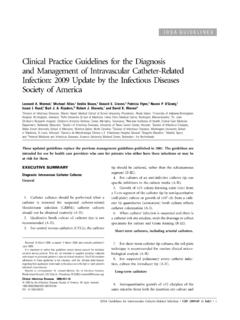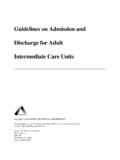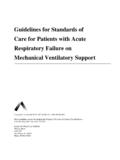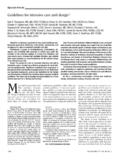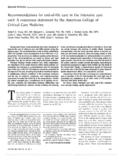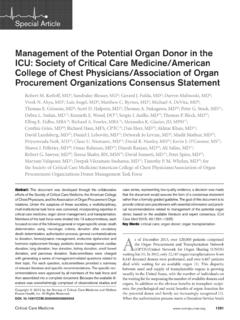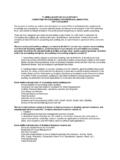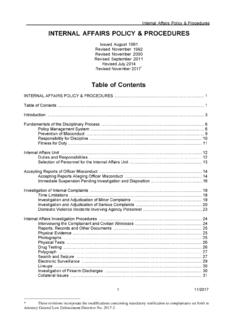Transcription of Special Pediatric Article - Society of Critical Care …
1 Special Pediatric Article guidelines and levels of care for Pediatric intensive care units David I. Rosenberg, MD; M. Michele Moss, MD; and the American College of Critical Care Medicine of the Society of Critical Care Medicine The practice of Pediatric Critical care medicine has matured structure, hospital facilities and services, personnel, drugs and dramatically during the past decade. These guidelines are pre- equipment, quality monitoring, and training and continuing edu- sented to update the existing guidelines published in 1993. Pedi- cation. (Crit Care Med 2004; 32:2117 2127).
2 Atric Critical care services are provided in level I and level II units. KEY WORDS: Pediatric Critical care medicine; administrative Within these guidelines , the scope of Pediatric Critical care ser- structure; hospital facilities and services; personnel; drugs and vices is discussed, including organizational and administrative equipment; quality monitoring; continuing education T. he practice of Pediatric Critical tion to the subspecialty. In 1990, the Res- level I PICUs should be located in major care has matured dramatically idency Review Committee of the Accred- medical centers or within children's hos- throughout the past 3 de- itation Council for Graduate Medical pitals.
3 It is also recognized that in the cades. Knowledge of the Education completed its first accredita- appropriate clinical setting and as a result pathophysiology of life-threatening pro- tion of Pediatric Critical care medicine of many forces, including but not limited cesses and the technological capacity to training programs. In 1986, the American to the presence of managed care, the in- monitor and treat Pediatric patients suf- Association of Critical Care Nurses devel- sufficient supply of trained Pediatric in- fering from them has advanced rapidly oped a certification program for Pediatric tensivists, and geographic and transport during this period.
4 Along with the scien- Critical care, and in 1999, a certification limitations, level II PICUs may be an ap- tific and technical advances has come the program for clinical nurse specialists in propriate alternative to the transfer of all evolution of the Pediatric intensive care Pediatric Critical care was initiated. critically ill children to a level I PICU. unit (PICU), in which Special needs of In view of recent developments, the The level I PICU should provide care critically ill or injured children and their Pediatric Section of the Society of Critical to the most severely ill patient popula- families can be met by Pediatric Special - Care Medicine and the Section on Critical tion.
5 Specifications for level I PICUs are ists. All critically ill infants and children Care Medicine and Committee on Hospi- discussed in detail in the text and are cared for in hospitals, regardless of the tal Care of the American Academy of Pe- summarized in Table 1. Level I PICUs will physical setting, are entitled to receive diatrics believe that the original guide- vary in size, personnel, physical charac- the same quality of care. lines for levels of PICU care from 1993 (1) teristics, and equipment, and they may In 1985, the American Board of Pedi- should be updated.
6 This report represents differ in the types of specialized care that atrics recognized the subspecialty of pe- the consensus of the three aforemen- are provided ( , transplantation or car- diatric Critical care medicine and set cri- tioned groups and presents those ele- diac surgery). Physicians and specialized teria for subspecialty certification. The ments of hospital care that are necessary services may differ between levels, such American Boards of Medicine, Surgery, to provide high-quality Pediatric Critical that level I PICUs will have a full comple- and Anesthesiology gave similar recogni- care.
7 The concept of level I and level II ment of medical and surgical subspecial- PICUs as established in the guidelines set ists, including Pediatric intensivists. Each forth in 1993 will be continued in this level I and level II PICU should be able to All committee reports from the American Academy report. Individual states may have PICU address the physical, psychosocial, emo- of Pediatrics automatically expire 5 yrs after publica- guidelines , and it is not the intent of this tional, and spiritual needs of patients tion unless reaffirmed, revised, or retired at or before that time.
8 Report to supersede already established with life-threatening conditions and their The American College of Critical Care Medicine state rules, regulations, or guidelines ; families. (ACCM), which honors individuals for their achieve- however, these guidelines represent the Some Pediatric patients with moder- ments and contributions to multidisciplinary Critical consensus report of Critical care experts. ate severity of illness can be managed in care medicine, is the consultative body of the Society of Critical Care Medicine (SCCM) that possesses rec- Pediatric Critical care is ideally pro- level II PICUs.
9 Level II PICUs may be ognized expertise in the practice of Critical care. The vided by a PICU that meets level I speci- necessary to provide stabilization of crit- College has developed administrative guidelines and fications. The level I PICU must provide ically ill children before transfer to an- clinical practice parameters for the Critical care prac- multidisciplinary definitive care for a other center or to avoid long-distance titioner. New guidelines and practice parameters are continually developed, and current ones are system- wide range of complex, progressive, and transfers for disorders of less complexity atically reviewed and revised.
10 Rapidly changing medical, surgical, and or lower acuity. It is imperative that the Copyright 2004 by the Society of Critical Care traumatic disorders occurring in pediat- same standards of quality care be applied Medicine and Lippincott Williams & Wilkins ric patients of all ages, excluding prema- to patients managed in level II PICUs and DOI: ture newborns. Most, although not all, level I PICUs. Requirements for level II. Crit Care Med 2004 Vol. 32, No. 10 2117. Table 1. Minimum guidelines and levels of care for Pediatric intensive care units (PICUs). Level I Level II.
